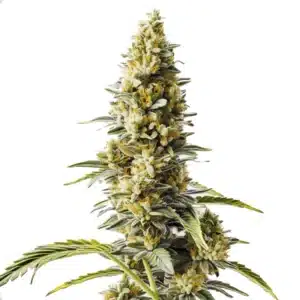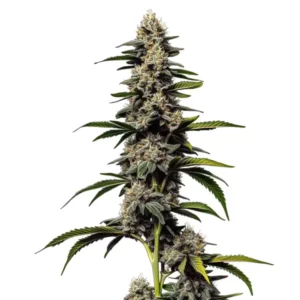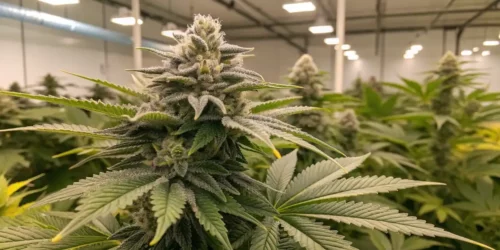Growing cannabis is an art that begins with mastering the seedling stage. Cannabis seedlings are delicate and require careful attention to develop into robust, healthy plants. Whether you’re an experienced grower or just learning how to start pot plants from seeds, perfecting cannabis seedling care is key to achieving a successful harvest. This guide will take you through every step of nurturing your seedlings, ensuring they flourish in any environment.
Why Proper Care Is Crucial for Seedlings
Cannabis seedlings are in their earliest and most fragile stage. They are highly vulnerable to environmental stress, nutrient imbalances, and physical damage. Proper care during this stage is critical because it sets the foundation for the plant’s overall health and productivity. Neglect can lead to stunted growth, reduced yields, or even plant failure. Investing time and effort in seedling care is not just beneficial—it’s essential.
Healthy seedlings are more likely to resist pests, diseases, and other challenges that may arise later. Well-cared-for seedlings also develop a robust root system, vital for absorbing nutrients and water effectively. This health foundation allows the plant to transition smoothly into the vegetative and flowering stages, ultimately leading to a more bountiful harvest.
Common Mistakes in Seedling Care
Even experienced growers can make mistakes during the seedling stage. Overwatering is a common error, leading to root rot—a condition that can be fatal to young plants. Another mistake is exposing seedlings to too much light or placing the light source too close, causing light burn or stress. On the flip side, insufficient light can cause “stretching,” where seedlings grow tall and weak as they reach for light.
Using nutrient-rich soil or feeding seedlings with strong nutrient solutions too early is another common mistake. Seedlings need minimal nutrients in their early days, and over-fertilizing can cause nutrient burn, leading to discolored leaves and stunted growth. These pitfalls and how to avoid them is key to nurturing healthy, vigorous seedlings that can withstand later challenges.
Promos & Deals
Setting Up the Ideal Environment for Cannabis Seedlings
Cannabis Seedling Care: Temperature and Humidity Requirements
Creating the perfect environment for cannabis seedlings involves carefully controlling temperature and humidity. Seedlings thrive in a warm environment, ideally between 70-80°F (21-27°C). Maintaining this range helps keep their metabolic processes functioning optimally. If temperatures drop too low, growth can slow, while excessively high temperatures can cause heat stress.
Humidity is equally important, especially in the early stages when seedlings are most vulnerable to drying out. A humidity level of 60-70% is ideal, as it keeps the delicate leaves from losing moisture too quickly. Using a humidity dome or a small grow tent can help maintain these conditions by trapping moisture and warmth around the seedlings. Monitoring these factors with a reliable thermometer and hygrometer is essential for giving your seedlings the best start.
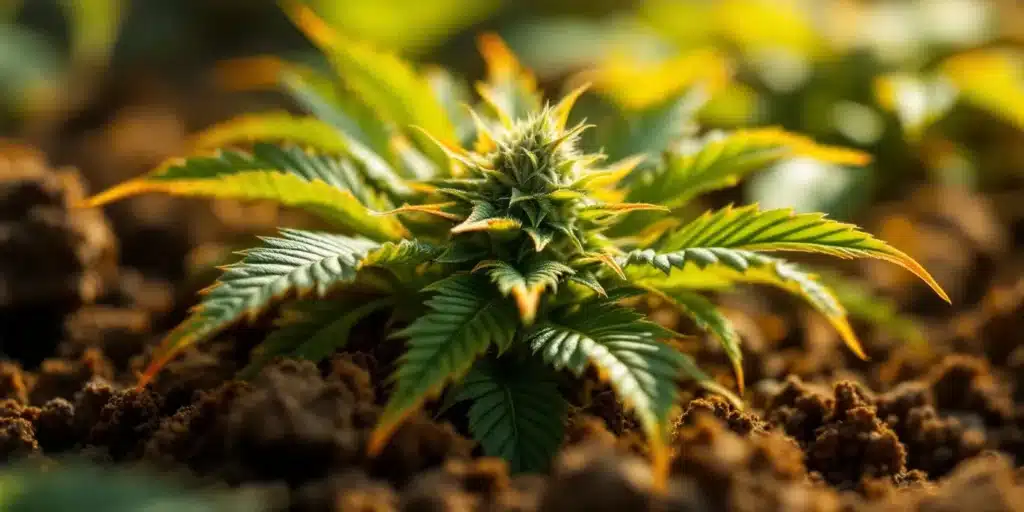
Cannabis Seedling Care: Lighting for Seedlings: Choosing the Right Type and Intensity
Light is one of the most critical factors in cannabis seedling care. However, seedlings require much less intense light than mature plants. The best lighting options for seedlings include CFL (compact fluorescent lamps) and LED grow lights. These lights should be positioned 6-12 inches above the seedlings to provide adequate light without causing heat stress.
The type of light matters too. CFL lights are popular among beginners because they are affordable and emit a soft, white light that’s gentle on seedlings. LED lights offer more control over light intensity and spectrum, making them ideal for more experienced growers. As seedlings grow, they will need more light, so gradually increasing the intensity as they mature is crucial for preventing issues like stretching or weak stems.
Cannabis Seedling Care: Soil vs. Hydroponics: Which Is Better for Seedlings?
Choosing between soil and hydroponics for growing cannabis seedlings depends on your goals and experience level. Soil is a traditional and forgiving medium, providing a natural buffer for nutrients, which helps prevent nutrient burn in seedlings. It also supports beneficial microbes that aid in nutrient uptake and protect against pathogens.
Hydroponics offers faster growth and greater control over nutrient intake but requires a more precise approach. In hydroponics, nutrients are delivered directly to the roots through a water-based solution, allowing for faster absorption and quicker growth. However, this method requires careful monitoring and adjustment of pH and nutrient levels to avoid deficiencies or toxicities.
For beginners, soil is often recommended due to its ease of use and forgiving nature. Hydroponics, while offering faster growth, may be better suited for more experienced growers looking to maximize speed and yield. Both methods can produce healthy seedlings, but they require different care strategies and levels of expertise.
Cannabis Seedlings Care: Watering and Feeding
How to Water Seedlings Without Overdoing It
Watering weed seedlings requires a delicate balance. Too much water can cause root rot, while too little can dry out the seedlings. The key is to keep the soil consistently moist but not waterlogged. One effective method is watering from the bottom by placing containers in a shallow tray of water. This allows the soil to absorb water gradually without disturbing delicate roots.
Another method is using a spray bottle to mist the soil lightly, keeping it damp but not soggy. Avoid watering directly on the seedlings, as this can damage young leaves and stems. As seedlings grow, their water needs will increase, so adjusting the watering frequency and volume is crucial for supporting healthy development.
Nutrient Needs: When and How to Feed Seedlings
Cannabis seedlings have minimal nutrient needs in their early stages. Most nutrients are already present in the seed itself, so additional feeding is unnecessary until seedlings develop their first true leaves. At this point, you can introduce a mild nutrient solution designed for seedlings to support growth.
When feeding seedlings, start with a diluted solution, usually at a quarter of the recommended strength for mature plants. Gradually increase nutrient concentration as seedlings grow to help them adjust without the risk of nutrient burn. Monitoring for signs of nutrient deficiency, such as yellowing leaves or stunted growth, will help you determine when to adjust their feeding regimen.
Dealing with Common Seedling Problems
Identifying and Treating Seedling Stretch
Seedling stretch is common when seedlings don’t receive enough light. In an attempt to reach the light source, seedlings grow tall and thin, resulting in weak stems that can topple over. To prevent this, ensure your seedlings receive adequate light. Placing the light source closer and maintaining a stable temperature can reduce the risk of stretching.
If seedlings have already started to stretch, correct it by replanting them deeper in the soil, burying part of the elongated stem. This stabilizes seedlings and encourages stronger root development. Adding a gentle breeze with a small fan can also help seedlings develop thicker stems, reducing the risk of stretching further.
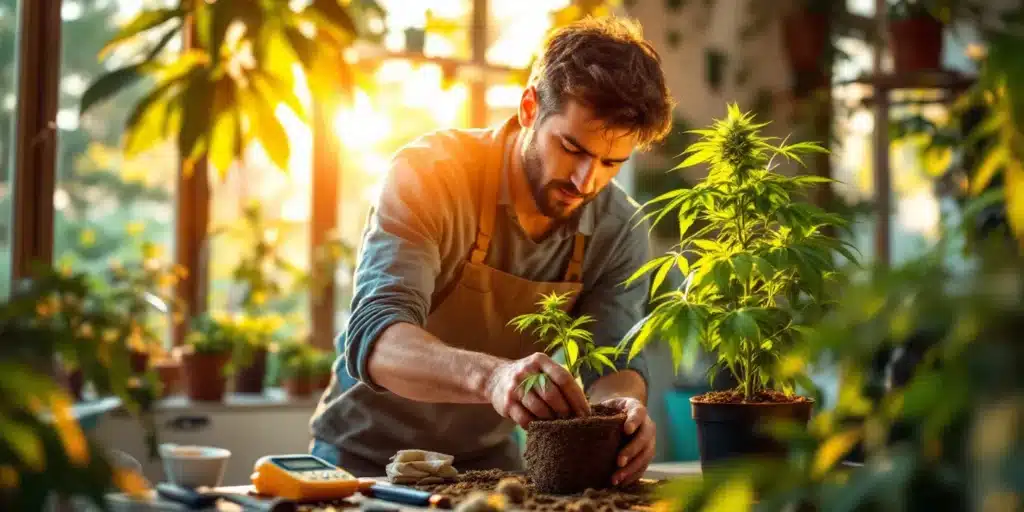
Preventing and Managing Pests in Cannabis Seedlings Care
Pests can pose a significant threat to cannabis seedling care, as their delicate nature makes them vulnerable to damage. Common pests include fungus gnats, spider mites, and aphids. Preventing pests involves maintaining a clean grow space and regularly inspecting plants for signs of infestation.
If pests are detected, act quickly to prevent further damage. Natural remedies like neem oil or insecticidal soap can effectively manage pests without harming seedlings. Introducing beneficial insects, like ladybugs or predatory mites, can also help control pest populations naturally. Regular monitoring and prompt action are key to protecting your seedlings from pest-related issues.
Signs of Nutrient Deficiency in Seedlings
Nutrient deficiencies in cannabis seedlings can manifest in various ways, including yellowing leaves, brown spots, or stunted growth. These symptoms often result from imbalances in soil pH or incorrect feeding practices. For example, a nitrogen deficiency may cause lower leaves to turn yellow, while a calcium deficiency can lead to brown spots.
To address nutrient deficiencies, diagnose the specific issue by observing symptoms and testing soil pH. Adjusting the nutrient solution or soil pH as needed can correct the deficiency and restore healthy growth. Regularly monitoring your seedlings’ health and making necessary adjustments will ensure they receive the nutrients needed to thrive.
Transplanting Seedlings: When and How to Do It
Knowing the Right Time to Transplant
Transplanting is a critical step in a cannabis plant’s life, and timing is crucial. The best time to transplant seedlings is when they have developed a strong root system and at least three sets of true leaves. Transplanting too early can shock seedlings, slowing growth or causing failure. Waiting too long can result in root-bound plants, where roots outgrow their container and become tangled.
To determine if seedlings are ready for transplanting, gently lift the container and check if roots are circling the bottom or sides. This indicates the seedling needs more space. If you notice growth slowing despite ideal conditions, it could be a sign that roots are constrained, signaling it’s time to transplant.
Cannabis Seedlings Care: Best Practices for Transplanting
When transplanting seedlings, handle them carefully to avoid damaging delicate roots. Prepare the new growing medium in advance, ensuring it’s well-drained and lightly moistened. The new container should be several times larger than the current one to give roots plenty of room to expand.
To transplant, gently squeeze the sides of the seedling’s current container to loosen the soil. Carefully tip the container and support the seedling as you slide it out, keeping the root ball intact. Place the seedling into the new container at the same depth as before. Fill any gaps with soil and lightly press down to secure the plant. Finally, water the seedling thoroughly to settle the soil and eliminate air pockets around the roots.
Long-Term Seedling Care: Ensuring Healthy Growth
Maintaining the Right pH Levels
The pH level of the soil or growing medium is crucial for cannabis seedling care. pH affects nutrient absorption, and an imbalance can lead to nutrient lockout, preventing the plant from absorbing essential nutrients even if they are present in the soil. Cannabis seedlings prefer a slightly acidic pH range: 6.0-7.0 for soil and 5.5
Regularly testing the pH of your water and nutrient solutions is crucial for maintaining the ideal range. Use pH testing kits or digital meters for accurate readings. If the pH is too high or too low, adjust it with pH up or down solutions designed for horticultural use. Keeping the pH within the optimal range ensures your seedlings can access the nutrients they need for healthy growth.
How to Harden Off Seedlings for Outdoor Growth
If you plan to move your cannabis plants outdoors, hardening off your seedlings is essential. This process gradually acclimates seedlings to outdoor conditions by exposing them to natural light, temperature changes, and wind. It builds resilience, reducing the risk of transplant shock and improving their chances of thriving outdoors.
To harden off seedlings, start by placing them outside in a sheltered spot for a few hours daily, gradually increasing their time outdoors over one to two weeks—this is a crucial step in growing marijuana from seed to harvest outdoor. Begin with an hour or two in the shade, then slowly introduce them to direct sunlight. Bring seedlings indoors or to a protected area during extreme weather, like strong winds or heavy rain. After this period, your seedlings will be better equipped to transition to their outdoor environment.
Choosing the Right Strain for Successful Seedling Growth
Choosing the right cannabis strain is a foundational step for successful seedling care and overall plant health. The strain you select influences growth patterns, yield potential, and resistance to pests and diseases. Consider factors like your growing environment (indoor vs. outdoor), climate, and goals (e.g., high yield, potency, or specific cannabinoid profiles).
Strains with strong genetics are more likely to produce healthy seedlings that resist common stressors. For beginners, it’s wise to choose a strain known for hardiness and ease of growth, like Blue Dream or Northern Lights. These strains are forgiving of minor mistakes and can thrive in various conditions, making them ideal for those still learning the ropes.

Best Strains for Beginners
For novice growers, selecting a strain that is easy to care for and resilient against common issues is key to success. Blue Dream is popular for its vigorous growth and pest resistance. Northern Lights is another beginner-friendly strain known for its compact size and fast flowering, ideal for limited spaces. White Widow is also a great option, offering strong disease resistance and adaptability to various growing conditions.
These beginner-friendly strains tend to have stable genetics, meaning they’re less likely to experience issues like hermaphroditism or unexpected growth patterns. This stability is particularly important for new growers who may not yet have the experience needed to troubleshoot complex problems.
High-Yield Strains for Experienced Growers
Experienced growers looking to maximize yields should consider strains known for producing large, dense buds. Big Bud is a classic choice, famous for massive yields and potent effects. Amnesia Haze offers high yields and a cerebral, uplifting high popular among sativa enthusiasts. Sour Diesel is another high-yielding strain known for its pungent aroma and energizing effects.
These strains often require more precise care, including optimal light levels, controlled nutrient delivery, and careful environmental management. For confident growers, these high-yield strains offer the potential for substantial rewards at harvest time.
Organic vs. Synthetic Nutrients: What’s Best for Seedlings?
Synthetic nutrients are manufactured to provide precise nutrient ratios tailored to cannabis plants’ needs. These nutrients are designed to be immediately available to the plant, leading to faster growth and more predictable results. They’re typically used in hydroponic systems, where they’re delivered directly to the plant’s roots through a water-based solution.
One advantage of synthetic nutrients is the control they offer. Growers can fine-tune the nutrient mix to match the plant’s needs at each growth stage. However, over-reliance on synthetic nutrients can lead to salt buildup in the soil, which can harm seedlings if not managed properly. Regular flushing of the growing medium and careful nutrient monitoring are essential when using synthetic nutrients.
Combining Organic and Synthetic Nutrients
Some growers combine organic and synthetic nutrients to benefit from both. This hybrid approach improves soil health organically while maintaining precise control over nutrient delivery. For example, a grower might use organic compost to enrich the soil and synthetic nutrients during critical growth phases to boost plant performance.
This method can be particularly effective for seedlings, providing gentle, steady nutrition from organic inputs and rapid growth from synthetic nutrients. By combining these approaches, growers can optimize seedling development and overall plant health.

Cannabis Seedling Care: The Growth Cycle
The germination stage is the first step in a cannabis plant’s life cycle, marking the beginning of the weed seedling stage. During this phase, the seed absorbs water, causing it to swell and crack open. The embryonic root, known as the radicle, emerges first, anchoring the seedling into the soil. Shortly after, the seedling pushes through the soil surface, revealing its first set of leaves, called cotyledons.
Germination requires a warm, moist environment to encourage seeds to break dormancy. Maintaining consistent moisture levels without overwatering is crucial, as excessive moisture can lead to mold or seed rot. Placing seeds in a dark, warm space with a temperature between 70-85°F (21-29°C) facilitates successful germination.
Transitioning from Seedling to Vegetative Stage
As the seedling grows and develops more sets of true leaves, it transitions from the seedling stage to the vegetative stage. This transition is marked by a noticeable increase in growth rate as the plant produces more leaves and expands its root system. During this phase, the seedling requires more intense light, a slight increase in nutrient intake, and more water to support rapid development.
It’s important to gradually increase light intensity to match the plant’s growing needs. Nutrient levels should also be adjusted, focusing on nitrogen, crucial for promoting healthy foliage. Consistent care during this transition helps establish a strong foundation for the vegetative stage, where the plant produces most of its leaves and stems.
Monitoring Growth Milestones
Throughout the seedling stage, it’s important to monitor key growth milestones, such as true leaf development and root expansion. Regularly checking your seedlings’ progress helps you identify issues early, like nutrient deficiencies, pests, or environmental stress. Monitoring milestones also helps you understand how your seedlings are progressing and when they’re ready to transition to the next growth stage.
During this phase, observe the color and size of the leaves, the seedlings’ overall height and structure, and the root system’s development. Healthy seedlings should have vibrant green leaves, sturdy stems, and a well-established root system that fills the container without becoming root-bound. If you notice signs of stress, like yellowing leaves, stunted growth, or drooping, address these issues promptly to prevent further problems.
Here’s how airflow affects Seedling Health
Airflow is crucial but often overlooked in seedling care. Proper air circulation helps prevent moisture buildup, leading to mold, mildew, and other fungal issues harmful to young seedlings. Good airflow also strengthens seedling stems by providing gentle resistance, encouraging more robust growth.
Without adequate airflow, humidity around seedlings can become too high, promoting pathogen growth. To ensure proper air circulation, run a fan in the grow space, even at a low setting. This keeps air moving and reduces the risk of fungal infections. The fan should not blow directly on seedlings, as this can dry them out or cause windburn. Instead, it should create a gentle breeze throughout the grow space.
Best Practices for Ventilation in a Grow Space
Ventilation is key to maintaining a healthy environment for seedlings. Besides using fans for air circulation, ensure you have a proper ventilation system that exchanges stale air with fresh air from outside the grow space. This is especially important in indoor grows where air can quickly become stagnant.
A good ventilation system helps regulate temperature and humidity levels and removes excess heat from grow lights. Depending on your grow space size, you may need an exhaust fan to remove hot air and an intake fan to bring in fresh, cooler air. This air exchange helps keep your seedlings healthy by preventing heat, humidity, and carbon dioxide buildup.
Using Fans to Strengthen Seedling Stems
Using fans to create a gentle breeze in your grow space significantly strengthens seedling stems. This breeze simulates the natural outdoor environment, where plants are exposed to wind, encouraging them to grow thicker, stronger stems to support their weight. Stronger stems can better support the plant as it grows and develops larger leaves and flowers.
When using fans, start with a low setting and gradually increase the intensity as seedlings grow. This helps them build strength over time without causing stress. Rotate fan direction occasionally to ensure even growth and avoid creating areas of too much or too little airflow.
FAQs
What is the best way to start pot plants from seeds?
The best way to start pot plants from seeds is to germinate them in a warm, humid environment using the paper towel method or directly in soil. Make sure to keep the medium moist and provide sufficient light once they sprout.
How do I care for marijuana plants from seed to harvest outdoors?
To successfully grow marijuana from seed to harvest outdoor, begin with strong genetics, ensure proper soil preparation, provide full sunlight, and protect seedlings from pests and extreme weather. Monitoring watering and nutrients at each growth stage is also key.
What should I expect during the weed seedling stage?
During the weed seedling stage, expect the plant to develop its first set of true leaves and focus on root establishment. It’s a delicate phase that requires proper lighting, humidity, and gentle care to support healthy growth.




